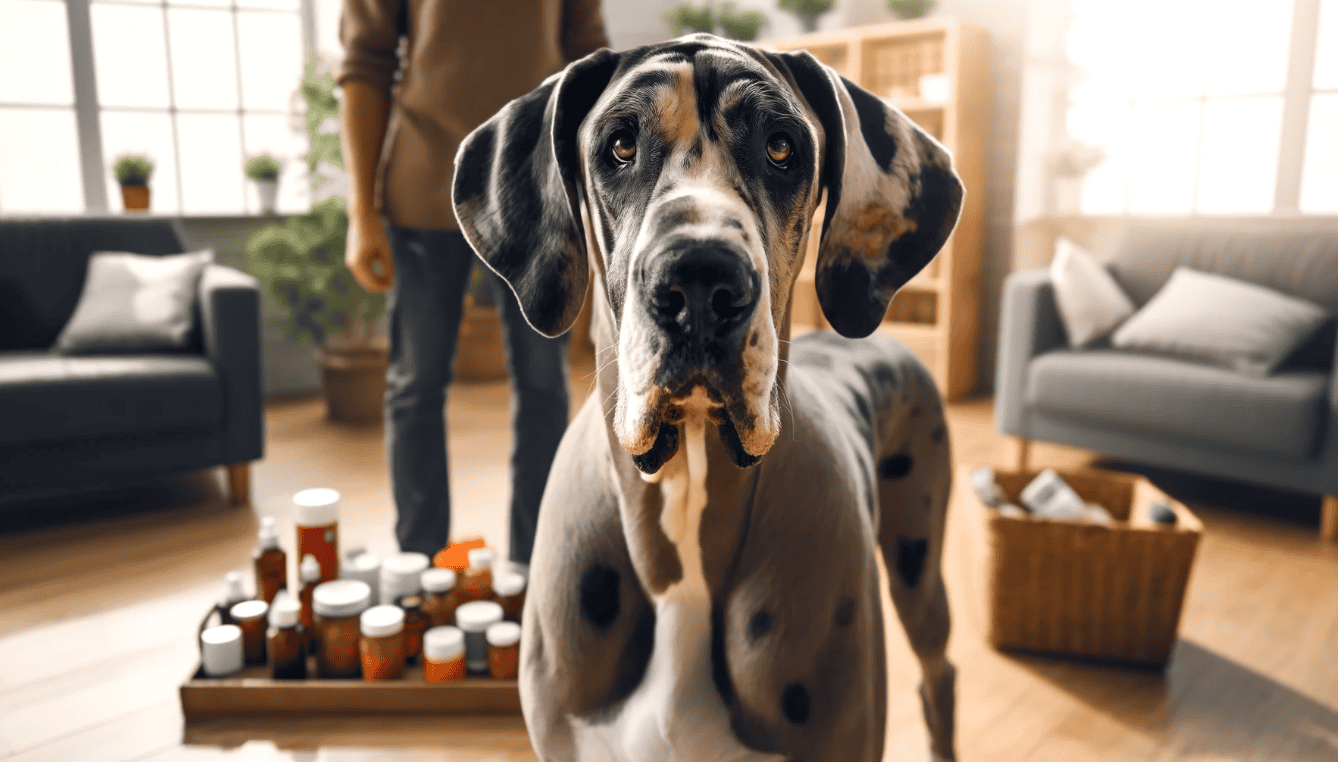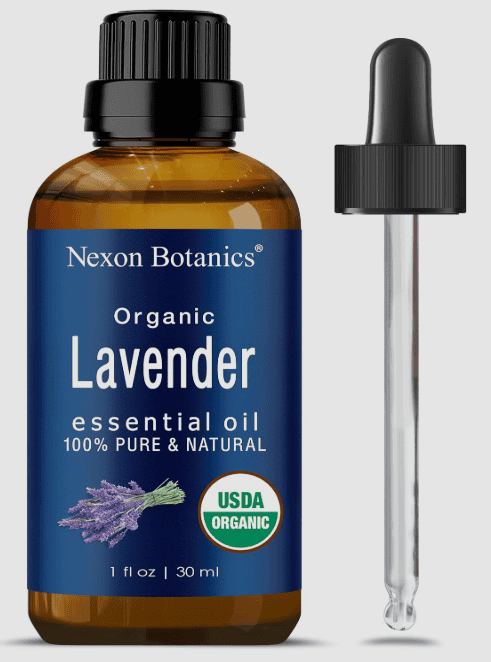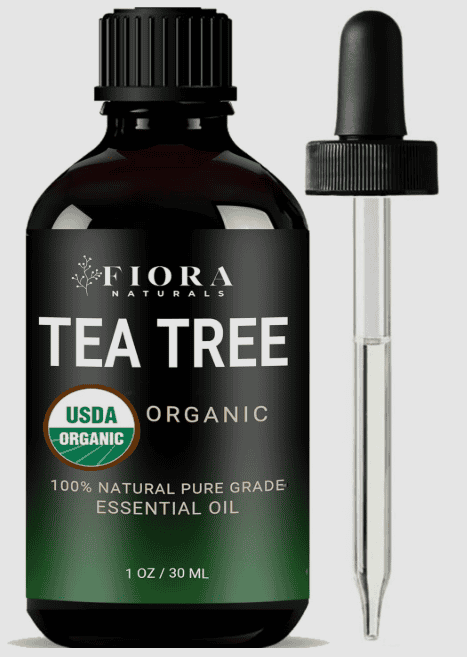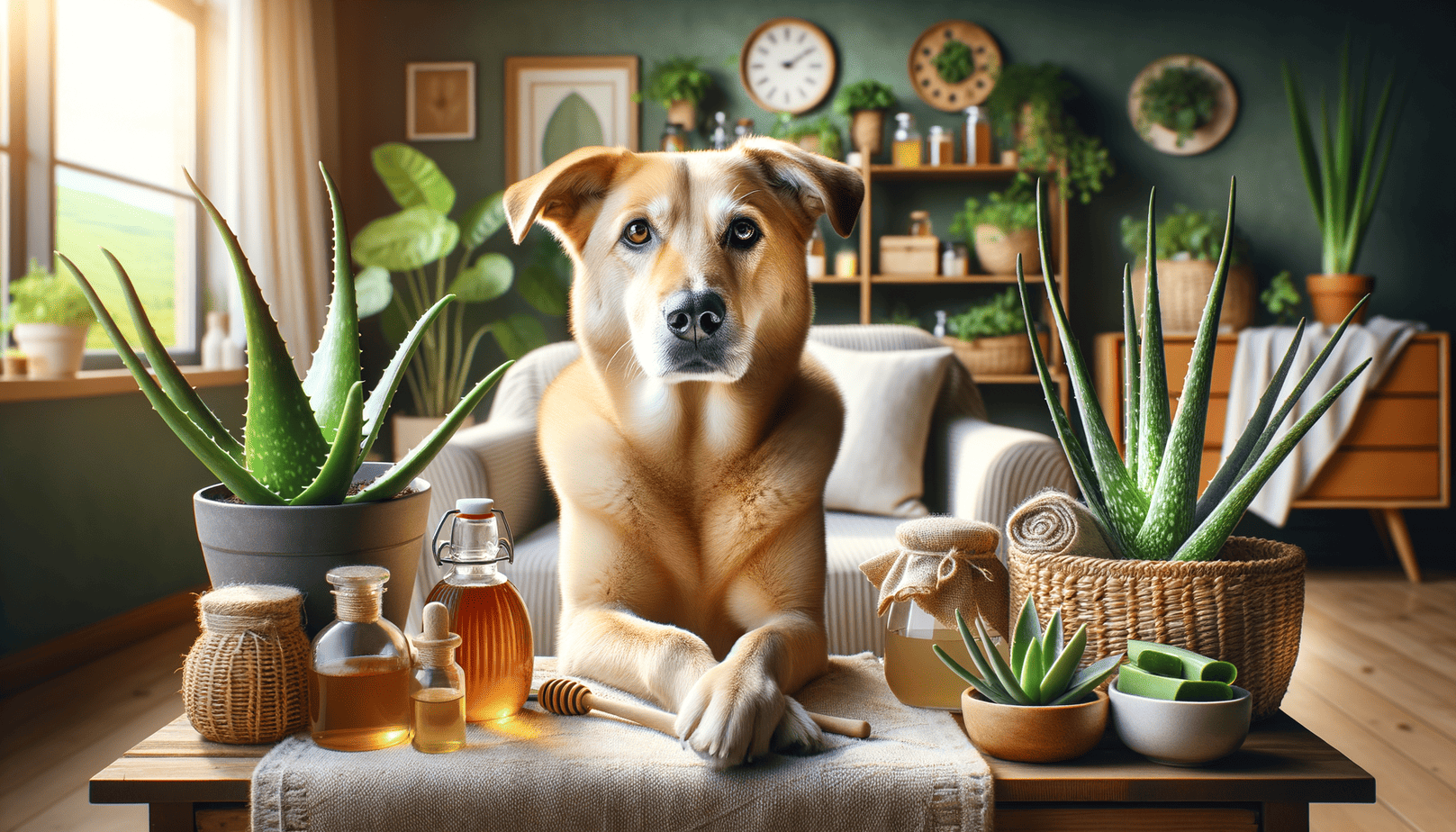As a holistic veterinarian, I understand the distress you feel when your furry friend is suffering from mange. It’s a skin condition that can cause severe discomfort for your beloved pet. But don’t worry, I’m here to guide you through some home remedies for mange in dogs that can help alleviate their symptoms. These natural treatments are not only effective but also safe for your canine companion. So, let’s embark on this healing journey together, and get your dog back to their happy, healthy self.

When it comes to your furry friend’s health, understanding the problem is half the battle won. In this case, we are dealing with a skin condition called mange, which comes in two main forms: Demodectic and Sarcoptic. Let’s dive into the details of these two types of mange in dogs and how they differ from each other.
Demodectic Mange in Dogs
Demodectic mange, also known as demodicosis or red mange, is caused by the Demodex mite. These microscopic mites are naturally present on the skin of dogs and only cause issues when their population spirals out of control. This usually happens when the dog’s immune system is compromised, either due to age (puppies and elderly dogs are more susceptible) or underlying health conditions. Symptoms of Demodectic mange include hair loss, redness, inflammation, and the formation of sores or scabs. This type of mange is not contagious to other dogs or humans.
Sarcoptic Mange in Dogs
Sarcoptic mange, or canine scabies, is a more severe condition caused by the Sarcoptes scabiei mite. Unlike Demodectic mange, Sarcoptic mange is highly contagious and can easily spread to other dogs and even humans. The mites burrow into the dog’s skin, causing intense itching, redness, and inflammation. This incessant scratching often leads to hair loss and the formation of scabs and sores. If left untreated, this condition can drastically affect the dog’s quality of life.
Understanding the type of mange your dog has is crucial in determining the right course of treatment. While both types cause discomfort and skin issues, their causes, treatment methods, and preventive measures differ significantly. Armed with this information, you can now start exploring home remedies for mange in dogs that can help soothe your pet’s discomfort and speed up their recovery. Remember, a healthy dog is a happy dog!
Importance of Natural Home Remedies
As a veterinarian, I often recommend home remedies for mange in dogs to pet parents who are looking for a natural approach to tackle this condition. These remedies are not only easy to implement but also offer several benefits.
Benefits of Using Natural Remedies for Canine Mange
Natural remedies can be an effective part of your pet’s overall health plan. Here are a few reasons why:
- Cost-effective: Most home remedies utilize ingredients that you already have in your pantry, making them a budget-friendly option.
- Non-toxic: Natural remedies are free from harsh chemicals, reducing the risk of side effects.
- Boosts immunity: Many natural remedies are rich in vitamins and minerals that can strengthen your dog’s immune system, helping them fight off mites more effectively.
Safety of Natural Home Remedies for Dogs
While natural remedies offer numerous benefits, it’s essential to remember that not everything natural is safe. Some herbs and oils can be toxic to dogs, so it’s crucial to research each ingredient thoroughly. Always start with small doses and monitor your pet for any adverse reactions. If you’re unsure, it’s best to consult with a vet before starting any new treatment.
Despite these precautions, many home remedies for mange in dogs are generally safe and can provide relief from symptoms such as itching, redness, and inflammation. With a consistent and careful approach, you can help your furry friend combat mange naturally.
Natural Home Remedies for Canine Mange
When dealing with canine mange, there are several natural remedies that could help in alleviating the discomfort and speeding up the healing process. Here are some top remedies that you can easily apply at home.
Using Essential Oils for Canine Mange
Essential oils are known for their antimicrobial properties and can be a great aid in treating mange.
Lavender oil is a good choice as it is gentle on the skin and helps to soothe irritation. Dilute it with a carrier oil such as coconut or olive oil before applying it to your dog’s skin.

Tea tree oil is another effective option, but it should be used with caution as it can be toxic if ingested or used in high concentrations. Always dilute it and avoid areas your dog can easily lick.

Herbal Treatments for Canine Mange
There are also several herbs that can help in treating mange.
Neem is a powerful natural remedy known for its antimicrobial and antiparasitic properties. You can use neem oil topically, or add neem leaves to your dog’s bath water.
Yellow dock root is another herb that can be used to treat mange due to its antiparasitic properties. Make a decoction by boiling the roots, strain it, and once cooled, apply it to the affected areas.
Aloe Vera is known for its healing and soothing properties. Applying aloe vera gel to the affected areas can provide relief from itching and promote healing.
Remember, while these home remedies can help, they should not replace a visit to the vet. Mange can be a serious condition and it’s important to get a proper diagnosis and treatment plan.
It’s also crucial to note that while these remedies are natural, they may still cause allergic reactions in some dogs. Always do a patch test first and monitor your dog closely for any adverse reactions. If you notice any signs of discomfort or worsening symptoms, discontinue use and consult your vet immediately.
Implementing these remedies along with a healthy diet and good hygiene practices can go a long way in helping your furry friend recover from mange.

Dietary Changes for Canine Mange Treatment
When it comes to treating mange in dogs, the food your dog consumes plays a significant role. A well-balanced diet can boost your dog’s immune system and help them fight off the mites causing mange.
Foods that Help in Treating Canine Mange
There are certain foods that can enhance your dog’s health and aid in the treatment of mange. Here are some beneficial foods to include in your dog’s diet:
- Omega-3 Fatty Acids: Foods rich in Omega-3 fatty acids, like fish and flaxseeds, help reduce inflammation and promote healthy skin and fur.
- Protein: High-quality proteins like chicken, turkey, and eggs are essential for maintaining your dog’s overall health and boosting their immune system.
- Fruits and Vegetables: Fresh fruits and vegetables like blueberries, spinach, and carrots are packed with vitamins and antioxidants that can help strengthen your dog’s immune system. They also help in the regeneration of skin cells.
- Probiotics: Foods containing probiotics, such as yogurt, can improve your dog’s gut health. A healthy gut can boost the immune system and help fight off mites.
Foods to Avoid when Treating Canine Mange
Just as some foods can help in the treatment of mange, there are also foods that can worsen the condition. Here are some foods you should avoid feeding your dog when they are suffering from mange:
- Processed Foods: These foods often contain artificial additives and preservatives that can weaken your dog’s immune system and aggravate mange symptoms.
- Grains: Some dogs may have a sensitivity or allergy to grains, which can cause skin inflammation and worsen mange symptoms.
- Sugary Foods: Sugar can suppress the immune system and make it harder for your dog to fight off the mites causing mange.
- Dairy: Some dogs are lactose intolerant, and consuming dairy products can lead to skin inflammation and exacerbate mange symptoms.
Remember, every dog is unique, and what works for one dog may not work for another. It’s always best to consult with your vet before making significant changes to your dog’s diet.
By making these dietary changes, you can help your dog fight off mange from the inside out, complementing the home remedies for mange in dogs you’re using externally. A healthy diet, combined with natural remedies and good hygiene practices, can go a long way in treating and preventing canine mange.
Hygiene Practices for Canine Mange Prevention
Regular Bathing and Cleaning for Dogs
One of the most effective home remedies for mange in dogs is maintaining regular hygiene practices. A vital part of this is regular bathing and cleaning. Bathing your dog with a gentle, hypoallergenic shampoo can help soothe their skin and remove any mites. It’s essential to ensure that the water is lukewarm and not too hot, as this can further irritate the skin.
Consider using a shampoo that contains natural ingredients known to combat mites, such as tea tree oil or neem. Remember to thoroughly rinse your dog to remove all traces of shampoo, as any residue can lead to skin irritation. Regular grooming can also help to remove dead skin and mites, and stimulate healthy skin growth.
Importance of a Clean Environment for Dogs
Alongside regular bathing and grooming, it’s crucial to keep your dog’s environment clean. Mites can survive for some time off your dog, so regular cleaning of their bedding and toys is necessary to prevent re-infestation. Wash your dog’s bedding in hot water and a gentle, fragrance-free detergent, and dry on high heat to kill any mites.
Regularly vacuum your home, paying particular attention to areas where your dog spends a lot of time. This will help to remove any mites and prevent them from spreading. It’s also recommended to clean any upholstery or carpets your dog has been in contact with.
Consider using natural sprays or powders designed to kill mites in your dog’s environment. Many of these products contain essential oils like eucalyptus or clove, which can be effective against mites but are safe for dogs and humans.
Remember, maintaining a clean environment is not just about eliminating mites. It also helps to reduce the risk of secondary bacterial or yeast infections, which can occur when your dog’s skin is damaged by mange.
In conclusion, while these hygiene practices are an essential part of managing and preventing mange, they should be used alongside other treatments, such as dietary changes and natural remedies. If your dog’s condition doesn’t improve or worsens, it’s important to seek veterinary care.

Veterinary Care Alongside Home Remedies
Even as we explore the effectiveness of home remedies for mange in dogs, it’s crucial to recognize the vital role that veterinary care plays in treating canine mange. Because every dog is unique, it’s essential to consult with a vet before starting any home treatments to ensure they’re safe and suitable for your pet.
When to Seek Veterinary Help for Canine Mange
While some cases of canine mange can be managed at home, there are instances when professional help is necessary. If your dog’s condition does not improve despite your efforts, or if it worsens, it’s time to seek veterinary help.
- Severe itching and discomfort that doesn’t subside with home treatments
- Signs of infection, such as pus or a foul smell
- Loss of appetite or lethargy
- Extensive hair loss or skin damage
These symptoms indicate a more serious condition that requires professional attention. Remember, your dog’s health and comfort should always be the top priority.
Role of Veterinary Care in Treating Canine Mange
While home remedies for mange in dogs can be effective, they should be used in conjunction with veterinary care, not as a substitute. Here’s why:
- Accurate Diagnosis: A vet can accurately diagnose the type of mange affecting your dog, which is crucial for effective treatment. Sarcoptic mange and demodectic mange, for instance, require different approaches.
- Professional Treatment: In severe cases, your dog may need prescription medication or special shampoos that can only be provided by a vet. These treatments can work faster and more effectively than home remedies.
- Monitoring Progress: Regular vet check-ups can help monitor your dog’s progress and adjust treatments as necessary. This is especially important for chronic or severe cases of mange.
In conclusion, while natural home remedies can play a significant role in managing canine mange, they should not replace professional veterinary care. Always consult with your vet before starting any new treatments, and don’t hesitate to seek help if your dog’s condition doesn’t improve or worsens. After all, our furry friends deserve the best care we can provide.
Natural Home Remedies for Canine Mange – A Success Story
When it comes to the effectiveness of home remedies for mange in dogs, countless pet parents can attest to their success. One such story involves a dog named Max, who suffered from severe Sarcoptic mange. After several failed attempts with conventional treatments, Max’s parents turned to natural home remedies. They incorporated a regimen of essential oils, herbal treatments, and dietary changes. Within weeks, Max showed significant improvement. His hair started growing back, and his constant itching subsided.
Max’s parents also ensured a clean environment and regular bathing, which minimized the mites’ reproduction. With time, Max was completely free from mange, a testament to the effectiveness of natural treatments. His story is just one of many that highlight the power of DIY mange remedies for dogs.
Final Thoughts on Natural Home Remedies for Canine Mange
Dealing with canine mange can be a challenging and distressing experience for you and your furry friend. However, the journey doesn’t have to be bleak. Natural home remedies for mange in dogs have proven to be a safe and effective option. They offer a gentle, non-toxic, and cost-effective solution to this common canine issue.
Remember, while home remedies can work wonders, it’s essential to consult your vet regularly. They can provide professional guidance to ensure your pup is on the right track to recovery. From essential oils and herbal treatments, dietary changes, to maintaining proper hygiene, these natural remedies can help your dog live a mange-free life.
So, as a dog parent, don’t lose hope. With patience, consistency, and a little natural help, you can help your furry friend fight mange and enjoy a comfortable, happy life.
Frequently Asked Questions
Q1: What are some natural home remedies for canine mange?
A1: Some natural remedies include honey, yogurt, apple cider vinegar, and olive oil. However, it’s important to consult with a vet before trying any home remedies.
Q2: How effective are natural home remedies for treating canine mange?
A2: The effectiveness of natural remedies can vary depending on the severity of the mange. In mild cases, they can help alleviate symptoms, but in severe cases, medical treatment may be necessary.
Q3: Are there any side effects of using natural home remedies for canine mange?
A3: Some dogs may have allergic reactions to certain natural remedies. Always monitor your dog’s reaction to a new remedy and stop using it if you notice any adverse effects.
Q4: How long does it take for natural home remedies to work on canine mange?
A4: The time it takes for natural remedies to work can vary. Some dogs may show improvement within a few days, while others may take weeks. If you don’t see any improvement after a few weeks, it’s best to consult with a vet.
Q5: Can I use natural home remedies as a preventative measure against canine mange?
A5: While some natural remedies may help boost your dog’s overall skin health, they are not guaranteed to prevent mange. Regular vet check-ups and good hygiene practices are the best preventative measures.
